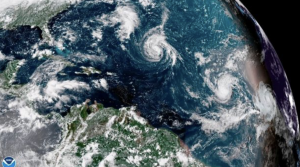Hurricane preparedness and what you need to know…

Hurricane season in the south is defined as June 1st – November 30th but most storms typically occur in September and October. Right now Charleston is keeping on eye on Hurricane Florence which is expected to make landfall sometime later this week.
One of the largest concerns my clients have is flooding and subsequently hurricane season and how to prepare. For people from Charleston–hurricane preparedness becomes almost second nature but if you are new to the area–it can be easy to panic once a storm is named and headed to the coast. The most important thing you can do is remain calm, don’t overreact or underreact and keep an eye on the news.
Here are some time for how to prepare for a hurricane:
1. Devise an evacuation plan:
If the governor declares a mandatory evacuation–you will want to decide where and how you will get out of town. It’s best to not wait until the last minute so you don’t get stuck in traffic. You will want to travel as far inland as possible since hurricanes lose their strength once they hit land and if you have a relative or friend you can stay with–take them up on their offer and develop an exit strategy.
2. Shelters
If evacuating isn’t an option for you or you have pets and don’t have a place to stay (never leave your pets behind!) then there are schools in your local area that will be turned into shelters. There are plenty of animal friendly shelters so be sure to identfy which one would be a good fit for you now and head there sooner rather than later to avoid them filling up.
3. Preparing at Home
Whether you decide to stay or go– you should make sure you put sandbags around your home to help prevent flooding and water getting into your home. Town Hall and Fire Departments in your area normally provide these–10 bags per family–and they are free until they run out. These can be true lifesavers for keeping water out of your house so make sure to get some! It’s like salt on the roads during ice storms–simple but so valuable!
4. Board Up Windows
If you live in a historic house–you will want to board up your windows with plywood. Simply go to Lowes or Home Depot and get plywood cut for the windows you want to protect the most and nail them on the outside of your home. Some people used to tape “X”s on their windows but this really doesn’t do anything as far as protecting your windows and will leave a sticky mess.
5. Water and Food
If you decide to ride out the storm– make sure you have enough food and water for 3 days, batteries, flashlights, candles and a generator with gas in case the power goes out. Keep in mind though, if there is a mandatory evacuation and you decide to stay–emergency personal might not be able to rescue you so you are really taking a risk.
6. Track the Storm
NOAA (The National Oceanic and Atmospheric Administration) provides regular hurricane tracking updates and will let you know where the storm is heading. NOAA normally gives updates every 3 hours and recently launched a great tool that tells you the storm surge in your particular area..
Hurricane preparedness can be a daunting task but if you devise a plan and follow it through, if will make things easier. Above all else stay safe and remain calm!
